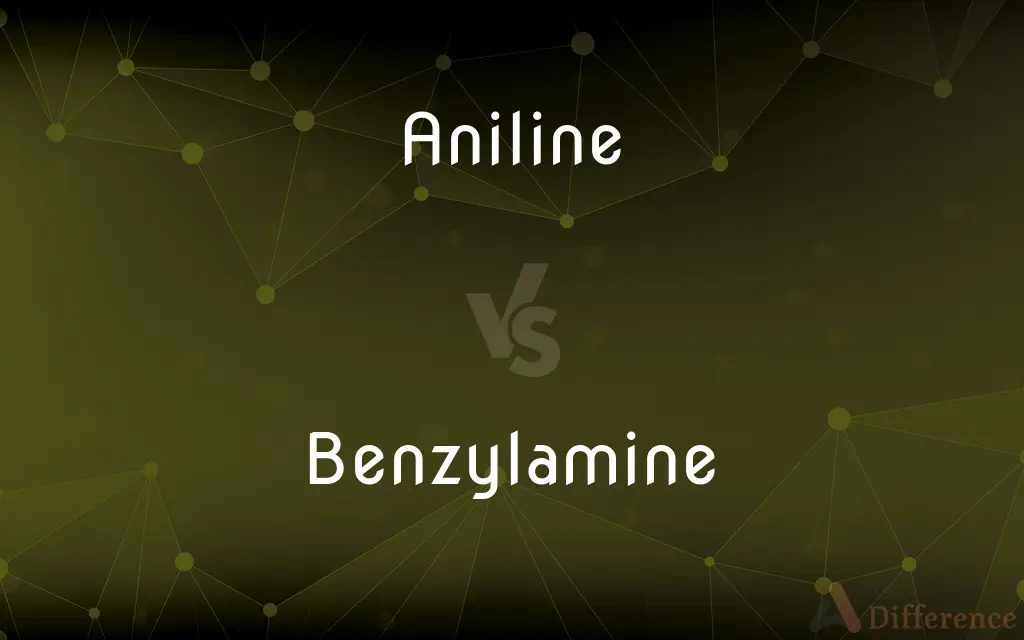Aniline vs. Benzylamine — What's the Difference?
By Tayyaba Rehman & Fiza Rafique — Updated on March 26, 2024
Aniline is aromatic amine with direct attachment of an amino group to benzene ring, used widely in dyes and pharmaceuticals. Benzylamine features an amino group attached to benzene ring via methylene bridge, known for its role in organic synthesis.

Difference Between Aniline and Benzylamine
Table of Contents
ADVERTISEMENT
Key Differences
Aniline, a foundational chemical in the dye and pharmaceutical industries, is characterized by its direct linkage of an amino group to a benzene ring, making it a primary aromatic amine. This structure imparts distinctive chemical properties, such as enhanced reactivity with electrophiles due to the electron-donating effect of the amino group. On the other hand, benzylamine includes an amino group that is attached to a benzene ring through a methylene (-CH2-) bridge, categorizing it as a primary aliphatic-amine. This structural difference significantly influences its reactivity and applications, especially in organic synthesis where it acts as an intermediate.
The solubility of aniline in water is limited, a trait common among aromatic amines due to their relatively nonpolar nature. This property affects its usage and handling in industrial processes. Whereas benzylamine, despite its similar limitation in water solubility, benefits from the methylene bridge, which slightly enhances its polarity compared to aniline, thereby slightly improving its solubility in water and making it somewhat more versatile in certain chemical reactions.
Aniline's boiling point reflects its aromatic amine nature, having a relatively high value due to the strong intermolecular forces, including hydrogen bonding. Benzylamine, while also capable of hydrogen bonding, has a slightly lower boiling point due to its aliphatic character, which generally leads to weaker intermolecular forces compared to aromatic compounds.
In terms of toxicity, aniline is known for its higher toxicity, which can pose significant health risks, including methemoglobinemia, upon exposure. This is attributed to its ability to undergo metabolic activation forming highly reactive species. Benzylamine, though not devoid of health risks, is generally considered to have a lower toxicity profile, making it slightly safer to handle under controlled conditions.
Regarding applications, aniline's role is predominantly seen in the manufacture of dyes, pharmaceuticals, and polyurethane foam. Its chemical structure is crucial for the synthesis of many compounds. Benzylamine finds its uses more in organic synthesis and as a precursor to certain pharmaceuticals, showcasing the versatility brought by its structural differences.
ADVERTISEMENT
Comparison Chart
Chemical Structure
Amino group directly attached to benzene ring
Amino group attached to benzene ring via methylene bridge
Solubility
Limited in water
Slightly better than aniline due to methylene bridge
Boiling Point
Higher due to strong intermolecular forces
Slightly lower, reflecting aliphatic character
Toxicity
Higher, with significant health risks
Generally lower toxicity profile
Primary Use
Manufacture of dyes, pharmaceuticals
Organic synthesis, precursor to pharmaceuticals
Compare with Definitions
Aniline
A primary aromatic amine with a distinct smell.
The laboratory was filled with the characteristic odor of aniline.
Benzylamine
A clear to yellowish liquid with a fishy odor, used in organic synthesis.
Benzylamine was used as a reagent in synthesizing the new compound.
Aniline
Used in the synthesis of polyurethane foam.
Aniline acts as a building block in the creation of flexible foam for upholstery.
Benzylamine
Slightly more water-soluble than aniline, offering versatility.
Benzylamine's solubility was beneficial in the aqueous phase of the reaction.
Aniline
A colorless, oily liquid used in the manufacture of dyes and drugs.
Aniline is a key ingredient in the production of indigo dye.
Benzylamine
Features an amino group connected to a benzene ring by a methylene bridge.
The presence of the methylene bridge in benzylamine enhances its reactivity.
Aniline
Toxic upon inhalation or ingestion, requiring careful handling.
Workers must use protective gear when handling aniline to avoid poisoning.
Benzylamine
Less toxic than aniline but still requires safety measures.
Despite its lower toxicity, handling benzylamine with care is imperative.
Aniline
Soluble in alcohol and ether, but only slightly in water.
Aniline's limited water solubility requires the use of organic solvents in reactions.
Benzylamine
Precursor to various pharmaceuticals and organic compounds.
Benzylamine serves as a starting material in many pharmaceutical syntheses.
Aniline
Aniline is an organic compound with the formula C6H5NH2. Consisting of a phenyl group attached to an amino group, aniline is the simplest aromatic amine.
Benzylamine
Benzylamine is an organic chemical compound with the condensed structural formula C6H5CH2NH2 (sometimes abbreviated as PhCH2NH2 or BnNH2). It consists of a benzyl group, C6H5CH2, attached to an amine functional group, NH2.
Aniline
A colorless, oily, poisonous benzene derivative, C6H7N, used in the manufacture of rubber, dyes, resins, pharmaceuticals, and varnishes.
Benzylamine
(organic compound) The aromatic primary amine C6H5-CH2-NH2 or its derivatives
Aniline
Derived from aniline.
Aniline
(organic compound) The simplest aromatic amine, C6H5NH2, synthesized by the reduction of nitrobenzene; it is a colourless oily basic poisonous liquid used in the manufacture of dyes and pharmaceuticals.
Aniline
An organic base belonging to the phenylamines. It may be regarded as ammonia in which one hydrogen atom has been replaced by the radical phenyl. It is a colorless, oily liquid, originally obtained from indigo by distillation, but now largely manufactured from coal tar or nitrobenzene as a base from which many brilliant dyes are made.
Aniline
Made from, or of the nature of, aniline.
Aniline
Oily poisonous liquid amine obtained from nitrobenzene and used to make dyes and plastics and medicines
Common Curiosities
Why is aniline more toxic than benzylamine?
Aniline's higher toxicity is due to its metabolic activation that forms highly reactive species, posing significant health risks.
What is the main structural difference between aniline and benzylamine?
Aniline has an amino group directly attached to a benzene ring, while benzylamine has this group attached through a methylene bridge.
What are the primary uses of aniline?
Aniline is primarily used in the manufacture of dyes, pharmaceuticals, and polyurethane foam.
Can aniline and benzylamine be used interchangeably in chemical reactions?
Due to their structural differences and resultant chemical properties, aniline and benzylamine cannot typically be used interchangeably in reactions.
How does the presence of a methylene bridge in benzylamine affect its chemical properties?
The methylene bridge in benzylamine slightly increases its polarity and solubility, affecting its reactivity and applications.
How does the solubility of benzylamine compare to aniline?
Benzylamine is slightly more soluble in water than aniline, due to its methylene bridge enhancing its polarity.
What safety precautions should be taken when handling aniline and benzylamine?
Protective gear and adherence to safety protocols are essential when handling both chemicals, due to their toxic nature.
Are aniline and benzylamine found in nature?
Both compounds are predominantly synthetic and not commonly found in natural settings.
What type of amines are aniline and benzylamine?
Aniline is a primary aromatic amine, while benzylamine is considered a primary aliphatic-amine.
How are aniline and benzylamine used in pharmaceuticals?
Aniline is used in the synthesis of various drugs, while benzylamine acts as a precursor to certain pharmaceutical compounds.
What is the boiling point of aniline compared to benzylamine?
Aniline has a higher boiling point than benzylamine, reflecting its stronger intermolecular forces.
Can aniline and benzylamine be mixed with water?
Both aniline and benzylamine have limited solubility in water, though benzylamine is slightly more soluble.
Why is aniline used in dye manufacturing?
Aniline's chemical structure makes it ideal for synthesizing a wide range of dyes, owing to its reactivity with various compounds.
Share Your Discovery

Previous Comparison
Photometry vs. Spectrophotometry
Next Comparison
Advil vs. AleveAuthor Spotlight
Written by
Tayyaba RehmanTayyaba Rehman is a distinguished writer, currently serving as a primary contributor to askdifference.com. As a researcher in semantics and etymology, Tayyaba's passion for the complexity of languages and their distinctions has found a perfect home on the platform. Tayyaba delves into the intricacies of language, distinguishing between commonly confused words and phrases, thereby providing clarity for readers worldwide.
Co-written by
Fiza RafiqueFiza Rafique is a skilled content writer at AskDifference.com, where she meticulously refines and enhances written pieces. Drawing from her vast editorial expertise, Fiza ensures clarity, accuracy, and precision in every article. Passionate about language, she continually seeks to elevate the quality of content for readers worldwide.














































